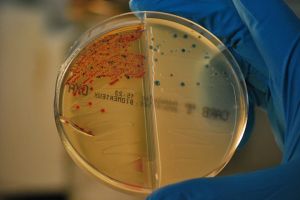“Los plásmidos son unas moléculas de ADN extracromosómico que se replican de manera autónoma y se transmiten de forma independiente del ADN cromosómico”, explica Álvaro San Millán, investigador del CNB-CSIC. “Su ventaja es justo esa, que se pueden transmitir entre bacterias no emparentadas confiriéndoles resistencia a uno o varios antibióticos. Normalmente se trata de multi-resistencia, al llevar varios genes de resistencia para distintos antibióticos. Los cromosomas, en cambio, solo se transfieren verticalmente (de células madres a hijas)”, añade.
En este sentido, la sensibilidad colateral es el fenómeno que se produce cuando los cambios fisiológicos y metabólicos asociados con el mecanismo de resistencia de una bacteria frente a un antibiótico concreto ocasionan que la bacteria sea más sensible a otro antibiótico distinto. “En otras palabras, la adquisición de resistencia a un antibiótico puede facilitar la actividad antimicrobiana de un segundo antibiótico. Hoy día se trata de una de las estrategias más prometedoras para diseñar tratamientos combinados o secuenciales impidiendo la evolución de la resistencia”, destaca San Millán.
Hasta ahora, las investigaciones en este campo se han centrado en casos asociados a mutaciones en el cromosoma de las bacterias. Sin embargo, la principal vía de evolución de resistencia a antibióticos en las bacterias de relevancia clínica no son estas mutaciones, sino la adquisición de plásmidos con genes específicamente dedicados a conferir resistencia a los antibióticos y que las bacterias pueden compartir entre sí. La principal novedad del trabajo radica en el uso de la sensibilidad colateral inducida por los mismos plásmidos, ya que juegan un papel fundamental en la diseminación de los mecanismos de resistencia.
“Hemos demostrado que ciertos plásmidos con relevancia clínica, aunque confieren resistencia a múltiples antibióticos, también inducen sensibilidad colateral a otros antibióticos. Utilizando combinaciones de fármacos a los que las bacterias demostraron sensibilidad colateral, hemos podido eliminar selectivamente las bacterias con plásmidos de resistencia”. De esta manera, “demostramos que los plásmidos pueden actuar como una espada de doble filo para las bacterias, ya que, a pesar de conferir resistencia a distintos antibióticos, también exponen el talón de Aquiles de la sensibilidad colateral”, apunta otra de las autoras del estudio, la investigadora Cristina Herencias, del grupo de San Millán en el IRYCIS.
Se abre así la posibilidad de explotar los efectos descritos en este trabajo para el desarrollo de terapias con múltiples antibióticos diseñadas específicamente contra las cepas que contienen plásmidos de resistencia. “Estas nuevas terapias podrían ser cruciales para controlar la alarmante diseminación de bacterias resistentes a antibióticos, como Klebsiella pneumoniae o Escherichia coli”, concluye el investigador del IRYCIS Jerónimo Rodríguez Beltrán.
Más información
Cristina Herencias, Jerónimo Rodríguez-Beltrán, Ricardo León-Sampedro, Aida Alonso del Valle, Jana Palkovičová, Rafael Cantón, Álvaro San Millán. Collateral Sensitivity Associated with Antibiotic Resistance Plasmids. eLife. DOI: 10.7554/eLife.65130
CNB y CSIC Comunicación






